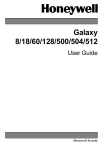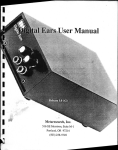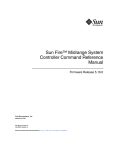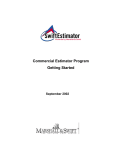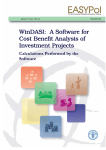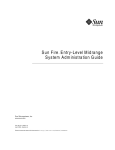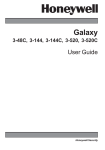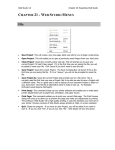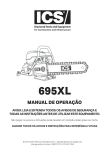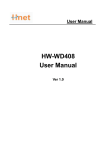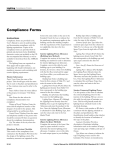Download A Software for Value Chain Analysis
Transcript
Resources for policy making EASYPol S eries 074 FAO VCA-Tool: A Software for Value Chain Analysis MANUAL FOR VERSION 3.1 by Lorenzo Giovanni Bellù, Policy Officer (Economist), FAO For the FOOD AND AGRICULTURE ORGANIZATION OF THE UNITED NATIONS, FAO About the Value Chain Analysis software This is a software for carrying out value-chain analyses for agricultural and rural development policies. By storing relevant data it can calculate flows of physical outputs and inputs, flows of aggregated costs, value-added and net benefits. In addition, it allows users to directly compare different hypothetical scenarios. FAO-VCA Software Tool» Value Chain Analysis for Policy Making: Methodological Guidelines for a Quantitative Approach» See all VCA resources on EASYPol resource package: Value Chain Analysis About EASYPol EASYPol is a multilingual repository of freely downloadable resources for policy making in agriculture, rural development and food security. The EASYPol home page is available at: www.fao.org/easypol. These resources focus on policy findings, methodological tools and capacity development. The site is maintained by FAO's Policy Support Group. The designations employed and the presentation of material in this information product do not imply the expression of any opinion whatsoever on the part of the Food and Agriculture Organization of the United Nations (FAO) concerning the legal or development status of any country, territory, city or area or of its authorities, or concerning the delimitation of its frontiers or boundaries. The mention of specific companies or products of manufacturers, whether or not these have been patented, does not imply that these have been endorsed or recommended by FAO in preference to others of a similar nature that are not mentioned. The views expressed in this information product are those of the author(s) and do not necessarily reflect the views of FAO. E-ISBN 978-92-5-107484-8 (PDF) E-ISSN 2219-9497 All rights reserved. FAO encourages reproduction and dissemination of material in this information product. Non-commercial uses will be authorized free of charge, upon request. Reproduction for resale or other commercial purposes, including educational purposes, may incur fees. Applications for permission to reproduce or disseminate FAO copyright materials, and all queries concerning rights and licences, should be addressed by e-mail to [email protected] or to the Chief, Publishing Policy and Support Branch, Office of Knowledge Exchange, Research and Extension, FAO, Viale delle Terme di Caracalla, 00153 Rome, Italy. © FAO 2012 Acknowledgements The author would like to acknowledge with thanks the contribution of Nathalie Guilbert who tested the software and volunteered to review the first draft of this manual, Paola Landolfi who edited and formatted the documents, Lucia Battaglia, Fabrizio Moscatelli and Ilaria Tedesco who contributed with their extensive revision to finalize the document. The VCA software was developed by Carlo Cappi and Lorenzo Giovanni Bellù with contributions of other colleagues of FAO. FAO VCA-Tool: A Software for Value Chain Analysis Manual for version 3.1 Table of contents 1. Summary ....................................................................................... 1 2. Installing the FAO VCA-Tool software ................................................. 2 2.1. How to install the software .................................................................... 2 2.2. How to uninstall the FAO VCA-Tool......................................................... 3 2.3. Technical notes for installation and use .................................................. 3 3. Basic structure of the software.......................................................... 5 3.1. Dashboard description .......................................................................... 5 3.1.1. Main menu bar ........................................................................... 6 3.1.2. Components bar......................................................................... 8 3.2. Components ........................................................................................ 9 4. Data insertion and management ...................................................... 10 4.1. Creating and saving a project ............................................................... 10 4.2. Data insertion and management ........................................................... 11 4.2.1. Basic functions ..........................................................................11 4.3. The Components ................................................................................15 4.3.1. Commodities (and services)........................................................ 15 4.3.2. Activities ..................................................................................16 4.3.3. Plans ....................................................................................... 18 4.4. Options of the software .......................................................................23 4.4.1. Languages ................................................................................24 4.4.2. Parameters ...............................................................................24 4.4.3. Price to be used ........................................................................25 4.5. Other features of the software .............................................................. 26 4.5.1. Exporting VCA data to Excel ....................................................... 26 4.5.2. Print function ............................................................................26 4.5.3. Show component function .......................................................... 27 4.6. Closing VCA ....................................................................................... 28 5. Special functions: Supply and Utilization Account (SUA) ...................... 28 5.1. How to make an adjustment ................................................................ 28 6. How to perform the calculations ....................................................... 34 6.1. Costs and benefits ..............................................................................34 6.1.1. Regular features .......................................................................34 6.1.2. Calculating aggregates ............................................................... 36 6.1.3. Comparing scenarios .................................................................38 6.1.4. Selecting parameters .................................................................41 FAO VCA-Tool: A Software for Value Chain Analysis Manual for version 3.1 6.2. Calculation of reference prices .............................................................. 42 6.2.1. Tradable commodities ..................................................................44 6.2.2. Non-tradable commodities ............................................................ 49 6.2.3. Import data function ....................................................................51 6.3. Policy analysis matrix (PAM) ................................................................ 52 6.3.1. The Policy Analysis Matrix .......................................................... 54 6.3.2. Price analysis ............................................................................55 6.3.3. Shares transfer .........................................................................56 7. Statistics function........................................................................... 58 8. Text files ....................................................................................... 62 8.1.1. Change the name of an item ....................................................... 64 9. Errors Reporting Procedure.............................................................. 65 10.Readers’ notes .............................................................................. 65 FAO VCA-Tool: A Software for Value Chain Analysis 1 Manual for version 3.1 1. SUMMARY FAO’s VCA-Tool is a software 1 that has been developed for Value Chain Analysis to analyze and compare the effects of different policy options for agriculture and sustainable rural development. The FAO VCA-Tool software allows you to create an accounting framework for value chain analysis and to compare different scenarios. It also helps you to build and handle your own database. The VCA software allows you to build different scenarios and to analyse the socio-economic impact of various policies such as domestic prices liberalization, opening to international trade, new technologies adoption, etc. The software allows you to build a baseline scenario which corresponds to a benchmark situation and once you generate the policy measures or changes in the value chain, their impacts will modify the original reference scenario. More specifically, the software enables you to systematically store data for the implementation of Cost-Benefit and Value Added Analyses and allows you to calculate: • • • • the flows and availability of physical quantities of inputs and outputs; the flows of aggregated costs, benefits, net benefits and value added, at agent and aggregate level; the flows of incremental costs, benefits, net benefits and value added for different policies; a set of economic indicators such as the profitability indexes, the indicators of protection and the indicators of competitiveness at international level (i.e. Effective Protection Coefficient, Domestic Resource Cost ratio). The FAO VCA-Tool software provides you with an effective alternative to spreadsheets, where you can standardize data, analyze complicated chains, automatically compute margins and selected indicators and compare scenarios. This manual provides detailed instructions on how to install the software, insert and manage data and carry out calculations of indicators for the different components and levels of a value chain analysis. The software is the complementary tool to the Value Chain Analysis for Policy Making Methodological Guidelines for a Quantitative Approach 2 which document provides the conceptual and methodological framework for value chain analysis. 1 Value Chain Analysis Software. FAO VCA Tool 3.1, EASYPol module 073. Bellù, L.G., 2012. Value Chain Analysis for Policy Making - Methodological Guidelines for a Quantitative Approach, EASYPol Module 129, FAO, Rome. 2 EASYPol Series 074 2 Analytical Tools You can follow links included in the text to other EASYPol modules or references 3. See also the list of EASYPol links included at the end of this module 4. 2. INSTALLING THE FAO VCA-TOOL SOFTWARE FAO’s VCA-Tool runs with Windows’98 and subsequent versions. You can download the FAO VCA-Tool as a zip file from FAO’s EASYPol website 5 and it is also available on CD-ROM upon request. 2.1. How to install the software It is recommended that you install VCA-Tool with the installer package. Download the file VCA.zip onto your desktop; alternatively, if you have the CD-ROM, copy the zip file into a folder of your choice on your computer. Then follow the step-by-step procedure to install the software: Step 1: Double click on the icon of the Package VCA 3.1.zip file. A new window with the content of the zip file will pop up on your screen. The zip file contains four different files: “VCA 3.1 July12.CAB”, “SETUP.EXE”, “SETUP.LST” and the “SUPPORT” folder 6. Step 2: Select a folder on your PC to unzip the VCA.ZIP. Step 3: Double click on the icon of the file SETUP.EXE and follow the instructions prompted on the screen. The FAO VCA-Tool software will be installed in the folder previously selected on your computer. By default, the software prompts the folder: C:\program files\VCA-Tool . Step 4: Create a link to the file VCA.EXE and copy its icon onto your desktop. Once the program has been installed, unless specified otherwise, you can update it with new versions of the software by simply replacing the VCA.exe file with a new VCA.exe file released by FAO. Click the VCA icon on your desktop to run the FAO VCA-Tool. Alternatively, open Windows Explorer, open the VCA folder and click on the file VCA.exe. 3 4 EASYPol hyperlinks are shown in blue, as follows: a) Resource packages are shown in underlined bold font b) other EASYPol modules or complementary EASYPol materials are in bold underlined italics; c) links to the glossary are in bold; and d) external links are in italics. This module is part of the EASYPol Resource Package: VCA software and manuals. EASYPol, resources for policy making www.fao.org/easypol. A CD is also available enclosed with the paper version of the manual. Send a “feedback” message: [email protected] 6 The README.TXT file contains a summary of this installation note. 5 FAO VCA-Tool: A Software for Value Chain Analysis 3 Manual for version 3.1 Some examples are provided with the software: to run the examples, open the FAO VCA-Tool program and load the exercise files by clicking on File and then on Open an Existing project. 2.2. How to uninstall the FAO VCA-Tool To uninstall the FAO VCA-Tool software from your computer use the uninstall facility of Microsoft Windows, if this is not available, carry out the following procedure: Step 1: Delete the VCA directory and its sub-directories. Step 2: Delete the VCA icon by clicking on it with the right-hand mouse button and selecting Delete. 2.3. Technical notes for installation and use 1. The software’s optimal visualization is at Display Resolution 1024x768 pixels or more. 2. The software can be used for only one session at a time (i.e. you cannot work on more than one project at the same time) because when you open or create a dataset a temporary file is originated. This file is the same for each session and if the software is opened for different sessions simultaneously, you risk saving your data incorrectly and with errors, which would be noticeable when the saved file is reopened. The FAO VCA-Tool works only with one temporary file, regardless the number of xxx you open, causing conflict among sessions and incorrect data storing. 3. Errors and malfunctions can occur when installing the software if you do not have administrator access. This occurs due to the creation of the temporary file temp in the sub-folder Data (where the software has been saved which is accessible by the software only if you have administrator access. To avoid errors and malfunctions, you must modify your user permissions to properly access the folder where the application is installed. Follow these steps to modify your user access permission: Step 1: Access the C:\Program Files\{Folder Name}. Step 2: Right-click on the folder FAO VCA-Tool and select Properties, see Figure 1. 4 EASYPol Series 074 Analytical Tools Figure 1: Changing user access rights: “Properties” folder (1/3) Step 3: Check the user permissions. Step 4: If your settings don’t allow you to full control the folder, you need to change your user access permissions to give you full control of the software. Figure 3 shows how to switch to a Full Control situation, flagging all the boxes in the security properties. FAO VCA-Tool: A Software for Value Chain Analysis Manual for version 3.1 Figure 2: Changing user access rights: “Properties” folder 3. BASIC STRUCTURE OF THE SOFTWARE 3.1. Dashboard description Figure 3: dashboard of the software. 5 EASYPol Series 074 6 Analytical Tools 3.1.1. Main menu bar The first element appearing when you open the software is the main menu bar, see Figure 4. The menu bar comprises the options Files, Tools, Options and Help commands. Figure 4: VCA-Tool main menu bar Click File too see the drop-down menu (see Figure 5). Figure 5: File drop-down menu The main commands of the File menu are: • New project: to clear all the project memory when you want to start a new project while another project is already loaded. • Open an existing project: to load the data of a project that has already been inserted and saved on the hard-disk. By default the software lists the files (*.VCA) stored in the Data subdirectory. Since the software allows you to save a project in three types of format, it is important that you choose the desired option (one file, two files, or text file, see Figure 6 below) from the drop down menu “Files of type”. Figure 6: Choosing the format file • Save: to save data from your working files. • Save as: to save your data in a directory and allows you to choose one of three types of file formats. You must give a name to the files and select the File type, while the extension is FAO VCA-Tool: A Software for Value Chain Analysis 7 Manual for version 3.1 prompted by the software (“.VCA” for one file; “1.VCA” and “2.VCA” for two files; and “.txt” for a text file). • Exit: to quit the VCA programme. Click on Tools to see the drop-down menu (Figure 7). Figure 7: Tools drop-down menu The main commands of the Tools menu are: • Calibration SUA (Supply Utilization Accounts): to balance the supply and demand of each ring of the chain or, in other words, to calibrate the distribution of the supply among the various consuming agents. • Statistics: to obtain an overview of a project’s data. It classifies the list of commodities in categories and identifies the various segments of the chain in the database. Click on Options to see the drop-down menu (Figure 8) Figure 8: Options drop-down menu The main commands of the Options menu are: • Languages: to select a preferred language to analyze the project. Once the project is saved, the selected language is also saved, so when you reload the project the same language will be used. • Types of prices: to choose whether the VCA analysis is carried out using market or reference prices. • Parameters: to define important parameters for the project. Click on Help and you will see two different options (Figure 9): EASYPol Series 074 8 Analytical Tools Figure 9: Help/About • Help: to find information on how to use the software. • About: to find information about the version of the software, the authors, assistance and the disclaimer. 3.1.2. Components bar The second element appearing when you open the software is the components bar. It includes the options related to the information on the project and on its single components: Commodities, Activities, Plans, Aggregates (see the left side of Figure 3). Once you open an existing project, you can see the list of its related components by clicking on Commodities, Activities or Plans. Double click on one of the listed items to display its content on the right of the dashboard. The dashboard on the right shows the value chain related data and allows you to create a component and compute data. Furthermore, the dashboard displays the options to carry out different data analysis such as cost and benefit analysis, value added computation, policy analysis matrix, etc 7. Finally, Project information leads you to a small text file where you can track detailed information related to the project such as, your hypothetical situation analysis or the data sources used to build the database. 7 The list of the analysis that can be carried through the software is extensively analyzed in the EASYPol module 129 Value Chain Analysis for Policy Making -Methodological Guidelines for a Quantitative Approach FAO VCA-Tool: A Software for Value Chain Analysis 9 Manual for version 3.1 3.2. Components To perform a value chain analysis with the FAO VCA-Tool software, you must create all the components that, combined together, define the economic content of the chain. The hierarchy within the components can be explained as follows: the commodity creates the activity, the activity creates the plan and the plan creates more plans 8. The FAO VCA-Tool approach goes from simple to more complicated 9 hierarchies, see Figure 10. Commodities In the FAO VCA-Tool software, the basic items of a value chain are the commodities sice they are considered to be the basic data of a production system, e.g., seeds, taxes, wheat, energy, labour. These assessable elements are involved in the production, processing and trading of the main outputs of the chain that become commodities themself. Activities The combination of some commodities allows you to model the value chain activities. In the case of an agricultural chain, the main activities are: commodity production, processing and trading. Plans You can combine basic commodities and activities to create plans. A plan corresponds to the top level of the hierarchy: it represents an agent, or a group of agents, a geographical area or an exploitation method. As shown in Figure 10, the FAO VCA-Tool software allows you to create “plans of plans”, that are basically plans combining other plans (and/or any other component). For example, the plan “Set of all producers ” includes different producer plans. 8 Refer to Chapter 2 of the EASYPol Module 129, Value Chain Analysis for Policy Making -Methodological Guidelines for a Quantitative Approach, for an extensive explanation. 9 Note that, when creating and formulating a value chain analysis (VCA), analysts generally start by defining the chain from general to particular. In VCA, this approach is reversed: the analyst should start by entering the basic data, the agents, and the other components of the project, to later switch to the activities and plans, through to the end of the chain EASYPol Series 074 10 Analytical Tools Figure 10: An example of assembling components in VCA 4. DATA INSERTION AND MANAGEMENT 4.1. Creating and saving a project Once you open the software it is recommended that you first select a language. English is used by default, however it is possible to switch to French or Spanish by clicking on Options, in the top menu and then on Language (Figure 11). Figure 11: Selecting a language Now you can insert the project name in the respective box (Figure 12). FAO VCA-Tool: A Software for Value Chain Analysis 11 Manual for version 3.1 Figure 12: Inserting the a project name Once the name of the new project is inserted, press the Enter button on the keyboard to save the new information. Before you save the project, at least one commodity must be registered. Once the first commodity is entered, the project can be saved by clicking on File and then on Save/Save as. By default, the software prompts the file extension format “.vca” (for example, myproject1.vca). The project is saved as a file in the folder of your choice. By default the folder is C:\Program Files\VCA\Data. NB You can change the file name but not the extension. If you need to change some data but keeping the original project, you must save the existing file using another name and then proceed with your changes. Click on File, Save as, and enter the new name. To open an existing file, click on File, then Open an existing file. If the you are already working on a project and you wish to open another existing project, you must click on File and New project or on File, Open an existing project and select the project on which to work on. This procedure reinitializes the software. Once the new file is opened, the non-saved information is lost because it is impossible to work on two projects during the same session (see WARNINGS in Chapter 2). 4.2. Data insertion and management 4.2.1. Basic functions The two main functions of the FAO VCA-Tool software are Inserting and Management of the commodities, activities and plans. To avoid duplication of the functioning mode of each component (Activity, Commodity, Plan) a common description is provided in Figure 12a. The specific characteristics of each component are described below. EASYPol Series 074 12 Analytical Tools Figure 12a: Basic functions of a component windows: Activities For each component you must enter the following information: i.Short Name: to identify the file commodity, activity or plan. It is advisable that you choose a short name to fit the related table cells and to make it easy to read. You can choose a combination of upper and lower case letters,for example, the component “set of producers” may be named “SetProd”. ii.Unit: to specify the related information of each component: • for the commodity, the unit chosen is the one defined by the price of the commodity. Example: price per pound, per gallon, per lot. • for the activity, the unit reflects the amount of commodities necessary to complete the defined activity. If the amount of inputs necessary per unit is known, the activity will be defined on the basis of the same unit. • for the plan, the unit defines the scope of the set of components in use. For example, for the plan “producer”, the unit represents one or more producers of an area or of a subsector. iii.Long name: to specify information about the component in the file name (e.g. the plan with “SetProd” can have a long name “Set of producers”). Once you have inserted all the components, you can save it/them by clicking Register Commodity/ Register Activity/ Register Plan. As shown in Figure 12a, the VCA-tool also allows you to use four more functions: Add items, Copy Values, Delete Item and Clear Form. • Add items: this is available only for activities and plans and allows you to create a new component on the basis of the existing ones. Once the option Activities or Plans is selected, click Add items to choose the category of the new item: Commodities, Activities, Plans or Aggregates (see Figure 12b). FAO VCA-Tool: A Software for Value Chain Analysis 13 Manual for version 3.1 To insert a new item, you must click In/Out Commodities. The screenshot in Figure 12c will appear. Select the item of interest and double clicking on it to add it to the list of the Selected Items. Once all the items of interest have been selected, click OK: a window will appear showing the selected items. The list can be saved following the above procedure. NB Double click on an item from this list to delete it. Figure 12b: Function “Add items” - Example drawn from the component Plan As mentioned earlier, the FAO VCA-Tool allows you to simulate a policy scenario. Once you have inserted your options, the tables collecting the data will display the policy scenario. The first column of the tables displays the Base Scenario situation and it is followed by numbered columns ranging from 1 to 50 and which also describe the policy scenario simulation (see Figure 13). The Base Scenario usually corresponds to the reference situation, i.e. the one for which data are available and specified. You can copy the base scenario data into the columns of your subsequent scenarios and then update them as needed once the policy measure 10 is applied. This process is carried out with the Copy Values function. i. Copy Values: to copy data from a selected scenario to the columns of the following scenarios by selecting the data from the chosen scenario and click on Copy Values. This function can be applied for the component Commodities, Activities or Plans. You can save the copied values by clicking on Register Commodity/Register Activity/ Register Plan. 10 Make sure that all related changes of your policy measure are inserted in the same column in the different windows of the software. All changes induced by the policy measure must be inserted in column 1. EASYPol Series 074 14 Analytical Tools Once the component is created and registered, click on File, Save to save it in the database of the project or click on Save as to build a new project. This step is necessary for you to save the component in your simulated policy project. ii. Delete Item: to delete an item. Click first on the line of the item to be deleted and then click Delete Item (see Figure 12c). iii. Clear Form: to cancel the data in the open window. Once the screen is clear, you can create new components. Figure 12c: Basic functions of the main menu When you create and save a component, it is added to the list of the other similar components, which are on the lefthand side of the dashboard. Double click on a component of the list in the left part of the dashboard and a window appears containing all the data related to that component. You can further classify the components already listed. To see the list of all commodities registered in the project click one of the buttons In/Out Commodities, Activities, Plans on the left side of the dashboard. Commodities, Activities and Plans are sorted by date of creation by default on the left side of the dashboard. You can change this to an alphabetic order by clicking the A-Z button (NB lowercase letters come after upper-case letters). Click UP or DOWN to move a selected item up or down the list. FAO VCA-Tool: A Software for Value Chain Analysis 15 Manual for version 3.1 Complex items evolve from the combination of basic items appearing in the activity or in the plan according to their order of insertion. Items can be sorted according to your needs by clicking UP or DOWN (see Figure 12c). To change the name of a component, you must open the list with the compent, select the component and click Modify Name, insert the new name, the name of the component is then updated everywhere in the database. Note i.To modify the name of a component, do not change it in the window of the component in the right side of the dashboard, as this would only modify the short name creating a new component but would not change the name of the existing file. ii.To delete a component from the database, you should open the component list, place the cursor on a component and click Delete Item. The component will be deleted from the database. iii.Everytime you make a change, click on Register (Commodity, Activity, Plan) on the window of the component to save the changes of the project and click on File, Save, to save the changes in the whole database. 4.3. The Components As already highlighted previously, the components Commodities, Activities and Plans constitute the base of the Value Chain Analysis in the FAO-VCA Tool. Each component is analyzed herebelow. 4.3.1. Commodities (and services) To have a clear idea of the development/analysis of the whold value chain you must identify the inputs and outputs needed to complete the different activities by listing all commodities and services (included in the In/Out Commodities box). You can also add commodities while setting up the chain. After inserting a short name, a unit and a long name 11 for each commodity (see Figure 13), you must: i. Specify whether the commodity is part or not of the value added; this information allows the software to automatically compute the value added for each activity and plan. ii. Specify whether the commodity is a depreciation item. iii. Enter a monetary unit price (the market price) on the basis of the defined unit and copy the values. iv. Enter an economic unit price (the reference price 12) on the basis of the defined unit and copy the value. v. Enter the non tradable part of the commodity at its market price. 11 12 See the basic functionalities in paragraph 4.2.1 See the EASYPol Module 129, Value Chain Analysis for Policy Making -Methodological Guidelines for a Quantitative Approach. EASYPol Series 074 16 Analytical Tools vi. Enter the non tradable part of the commodity at its reference price. vii. Save the Commodity. The above procedure will be further analysed in the following chapters. When the commodity is used in Activities or Plans, the physical amounts are expressed in total monetary value of input or output of the related activity. If you need to express the input or output in monetary terms but the price per unit is unknown, you can assign a value “1” to the unit price. Figure 13 : Window of the component Commodities 4.3.2. Activities To build a value chain you need to specify the amount of inputs necessary to complete an activity. An activity represents a set of input commodities combined to produce one or multiple commodities or outputs. In a value chain context, an activity is often associated to a stage of the chain as for example production, processing or trading of the main commodity. FAO VCA-Tool: A Software for Value Chain Analysis 17 Manual for version 3.1 Click on Activities on the left side of the dashboard window to open. Insert the short name of the activity, its unit and its long name 13 on the right side of the dashboard and then set up the activity by combining the commodities and the services as inputs necessary to complete the activity. It is important here to specify the outputs generated by the activity. To set up the activity, click Add Items 14 and select the commodities necessary to complete the activity. Then click OK, the window will close and the commodities selected will appear among the items of the activity. Now you need to specify the necessary amount of each commodity to complete a unit of the activity and the amount of output generated by each unit of the activity. In order to do so, insert the amount of each commodity, select the corresponding line, insert the number. If you want to copy the amount in all columns use the function Copy values. Make sure that there is coherence between the unit of the activity, the yield and the amount of inputs to be stored. Then click Register Activity to save the activity. The items are inserted in the activity as inputs by default. An output must be identified among the list of inputs inserted by selecting the line of the related commodity and clicking Change In/Out. The nature of the commodity will be converted from input to output (see Figure 14). Figure 14: Window of the Activities component Every input is characterised by the minus sign, since items are expenditures. The minus sign appears automatically once the window containing the input related information is opened again after you have saved the activity. To double check, after saving the activity, close the window and open it again to verify that the input commodity has a minus sign. 13 14 See paragraph 4.2.1. See paragraph 4.2.1. EASYPol Series 074 18 Analytical Tools 4.3.3. Plans Another fundamental step in the building process of a value chain is the identification of the agents implementing the activities. Creating a Plan is a similar process to that of an Activity. After inserting a short name, a unit and a long name 15, you can start creating the plan. A plan can involve any of the existing activities, commodities or plans. In general, the component Plan is used to model an agent or a group of agents. In the value chain, an agent can perform one or various activities. At the Plan level agents specify the number of times an activity is performed by the same agent. Then, depending on the measure unit of an activity (i.e. hectare of crop land or pound of output) you need to specify the units of output released by the agent. This concept is further clarified below with two examples: Example 1: Modelling a rice production activity (surface-based) • activity : rice production • unit of the activity : hectare In this example, the Plan “Rice producer” is created and the activity “Rice production” previously created is inserted in the Plan. In this Plan, the number of hectares of rice crop available for the agent is specified. This is why in this case the unit of the Plan is “one producer”. In this example, the unit “one producer” corresponds to the hectare since it is assumed that the agent only grows rice. Example 2: Modelling a rice production activity (weight –based) • activity: rice production • unit of the activity: pound of rice. In the Rice producer Plan, the number of pounds of rice produced by the agent is specified. As in the previous example, the unit of the Plan is defined as “one producer” and therefore as one pound of rice if the agent grows only rice. Hereafter six different possible combinations are presented and illustrated with some examples: a. A Plan made of one activity For example, a farmer who produces only rice. A plan named “Rice Producer” is created in the activity “Rice Production” which was previously created. As explained above, the number of times the activity is performed by the farmer must be specified. 15 See paragraph 4.2.1. FAO VCA-Tool: A Software for Value Chain Analysis 19 Manual for version 3.1 b. A Plan made of various activities If a farmer grows different types of crops (for example irrigated rice, rain rice and others) they correspond to different activities. A Plan named “All Rice Producer” is created and the activities “Irrigated Rice Production” and “Rain Rice Production” previously created are added to the Plan. As explained previously, the number of times each activity is performed by the farmer must be specified. c. A Plan made of a plan Once the Plan “Rice Producer” is defined and corresponds to the agent “Rice Producer”, a Plan of a plan can be created to analyse a set of rice producers and not only an individual agent. To perform this procedure a Plan of a plan named “Rice Producers” is created inserting the plan “Rice Producer” and the number of rice producers involved in the chain. d. A Plan made of various plans Assuming two Plans made of various plans are already created named “Irrigated Rice Producers” and “Rain Rice Producers”, respectively corresponding to the set of irrigated rice producers and the set of rain rice producers. The aim of the Plans of plans is to analyse the set of producers for every type of rice. A Plan “All Rice Producers” is created and the plans “Irrigated Rice Producers” and “Rain Rice Producers” are inserted. The number of times the activity is performed is, as usual, specified. In this case, there is only one set of irrigated rice producers and one set of rain rice producers. Therefore, a number “1” will be inserted on the line corresponding to each plan. e. A Plan made of various plans and one or various activities The plan “Rice Producer” has already been created. Some of the rice producers also produce onions. A Plan named “Rice/Onion Producer” is created and the existing plan “Rice Producer” is inserted too as the activity “Onion Production”. The Plan of the agent rice and onion producer has just been created. f. A Plan is made of activities/plans and one or various items In this example a farmer produces green beans, onions and garden peas. the cost for electricity for the overall exploitation identified by the whole price for the item “Electricity power” is known, but not the precise single costs related to each activity. A Plan representing the producer is made and the three activities (“Green Beans Production”, “Onions Production” and “Garden Peas Production”) are inserted as well as the item “Electricity power” previously created. This is also valid in case a tax paid on the overall exploitation including different crops. The “Tax” commodity is inserted at the Plan level, and not at the activity level. Example 3. How to model own final consumption of a producer The own final consumption of a producer in VCAis recorded as one component of the total output value of the production process and is valued at market prices (as long as they reflect its opportunity cost). For example let’s suppose that the total production of maize is 100 tons per 20 EASYPol Series 074 Analytical Tools year and that 40% is retained as own final use. In this case the production and income accounts of the economic activity “maize production” will look like the one depicted Figure 15: Own final consumption versus market sales Hereafter, three options to compute it as a component of the total output value are illustrated. On the basis of the nature and focus of the analysis she has to carry out, the user can choose the most suitable one. Option 1. One way of including own final use in the production accounts is to create an activity producing two outputs: the output for own final consumption (or home consumption) and the marketed output. Option 2. A second option is to represent the production and home consumption as two distinct activities. the “Maize Production” activity combines inputs and factors of production to obtain an agricultural commodity as output (i.e. maize). The “Own final consumption” activity buys part of this output and uses it as an input turning the agricultural commodity into the commodity retained for own final use (i.e. home consumed maize). These two activities correspond to two different agents, being one run by the producer and the second by the consumer. This option is in line with the representation found in most social accounting matrices and computable general equilibrium models, where home consumption is modeled as a payment from the household to the production activity16. Figure 16 depicts the logical scheme underlying this option. 16 In many computable general equilibrium models, the demand for home consumption results from the consumer decision on how to allocate his income between two commodities: a marketed commodity and a commodity for home consumption. In such models no function describes the producer’s choice on how to allocate production between market and home-consumption. FAO VCA-Tool: A Software for Value Chain Analysis 21 Manual for version 3.1 Figure 16: Flow Chart of Option 2 Option 3 Another option is to create one activity for production (i.e. maize), whose output is produced output (i.e. maize produced), and one activity allocating all production between market sales and own final consumption. Hence, the latter activity will have two outputs: share of produced output sold (i.e. maize sold) and share of produced output home consumed (i.e. home consumed maize). Figure 17 provide a figurative representation of the mechanism described. Figure 17: Flow chart of Option 3 EASYPol Series 074 22 Analytical Tools As for activities, the items (commodities) are inserted by default in the Plan as inputs. You can change the status of the commodity by clicking Change In/Out and the commodity is converted from input into output or vice versa. Once the components are inserted in the Plan, you need to specify the amount of each component required to define the plan. To specify the amount, place the cursor on the corresponding line on the right side of the dashboard, insert the corresponding figure and copy the value (Figure 18). Repeat all the procedures carried out for the Activity to save the Plan. Figure 18: Window of the component Plans Aggregates You can aggregate items using to the function Aggregated Commodities. This function is particularly useful to create balances or synthetic information, displayed further in the computing sheets released in VCA. For example, you can create the aggregate “Intermediate goods” gathering all the intermediate goods of an activity and/or an agent. In the same way, the balance “Gross Operating Income” is computed as the total value net of the labour costs, of the financial costs and the taxes. See below for detailed steps to create an aggregate: a. Click on Aggregated Commodities button in the left part of the sorting board. The window illustrated in the Figure 19 will pop up. FAO VCA-Tool: A Software for Value Chain Analysis 23 Manual for version 3.1 Figure 19 : Window of the component Aggregates b. Give a short name to the aggregate, as well as a long name if necessary. c. Click Add Items. d. Click In/Out Commodities and select the commodities from the list. Click on each commodity to be added to the selection and then click OK. e. Click Delete Item to remove a component from the aggregate. Place the cursor on the line of the commodity to be deleted and click Delete. f. When the aggregate is created, click Register Aggregate to save the aggregate. The coefficient that represents the quantity of the component used in the aggregate is set to 1 by default, but it can be changed if necessary in the range 0 to 1. For example, when only half the total value of a commodity is taken into account, the coefficient to be applied is 0.5. To create a balance, negative coefficients will be considered. For example, the aggregate outcome of an aggregate with commodity “A” for which the coefficient is 1 and an aggregate with a commodity “B” for which the coefficient is -1 will be “A - B”. 4.4. Options of the software As already mentioned before, the functions listed in the Option’s drop-down menu allow you to use three important tasks (see below for more details). EASYPol Series 074 24 Analytical Tools 4.4.1. Languages English is the default language, but it is possible to switch to French or Spanish language by clicking on Language. As already explained in section 3.1, once the project is saved, the selected language is also saved. Once you load the project, the same language will stand; 4.4.2. Parameters Parameters is in the Options menu which is located in the main menu bar. It helps define some basic adjustments for analysis. Figure 20: Selecting the paramenters 17 Scale Factor : You can convert and visualize the data in thousands or millions Figure 20), a feature that can ease data presentation and reading. A reminder appears ahead of the charts if the option thousands or millions has been selected. Number of decimals: to choose the number of decimals needed to better interpret data for the analysis (Figure 20) • Forex Data Entry: to choose and insert official and shadow exchange rates before the reference price 17 calculation. Clicking on Forex Data Entry (Figure 20) See the EASYPol Module 129, Value Chain Analysis for Policy Making - Methodological Guidelines for a Quantitative Approach FAO VCA-Tool: A Software for Value Chain Analysis 25 Manual for version 3.1 Select the currency corresponding to the data to be inserted in the chart. Three different currencies and their relative exchange rates can be inserted if necessary: “International currency”, “Regional currency” and “Other currency”. Insert the exchange rates and copy the values. Insert changes related to the chosen scenarios. Once you click on Compute Forex Premium, the Forex Premium Coefficient appears down in the chart (Figure 21). Click Save_Exit to save the project. Figure 21: Defining exchange rates 4.4.3. Price to be used You can choose either market or reference prices. It is possible to switch from market to reference prices and vice versa by clicking Options in the menu on the top and then selecting them on Type of prices (Figure 22). Figure 22: Selecting the prices to be used EASYPol Series 074 26 Analytical Tools 4.5. Other features of the software In this paragraph, three important functions of the software are explained and analyzed: the exporting data function, the printing function and the function allowing you to display the different components of the chain. 4.5.1. Exporting VCA data to Excel You can copy data or the calculation charts from the FAO VCA-Tool software to an Excel spreadsheet. See below : Step 1: Select the part of the chart to be copied by placing the cursor on the cells of the table to copy data onto the board on the right. The left upper corner of the part to be copied is always (0,0) and corresponds to the beginning of the entire original chart. Step 2: Click on the right button of the mouse and the following message will pop up (Figure 23). Figure 23: Exporting data to an Excel file There are two options you can choose to store the data on Excel: Option 1: If you click OK., the data copied will be stored in an Excel file with the same name and location of the VCA file. To access data exported in Excel, close the FAO VCA-Tool software, then open Excel and click File, Open. Go to the folder where the VCA file is located. Select the file “.xls” with the name of the project containing the recently copied data. Open the file, the copied data will be displayed. Different tables can be copied from the software. In order to collect all of them on the same excel file, you have to ensure that all files of interest have been copied before closing the software. When you re-openi the project, this function will copy the data into the same excel file substituting the data already saved. To avoid cancelling any previous data, you must change the name of the Excel file, or add data to it by means of the clipboard (see Option 2). Option 2: Click on Cancel, to copy and store data in the clipboard. You can then paste data into any Excel file of your choice. 4.5.2. Print function With the FAO VCA-Tool you can print any of the tables created by the software (commodity, activity, plan, PAM, scenarios, etc). FAO VCA-Tool: A Software for Value Chain Analysis 27 Manual for version 3.1 To print these tables, just click Print Form on the menu bar of the table you want to print (Figure 24). Figure 24: Print form 4.5.3. Show component function If you click in the activity table on ShowComponent in the top menu bar, it displays the details of the input or output selected in the table of the current activity showing the prices of the commodity for which you need information (Figure 25). To select the commodity, click on the name of the commodity and a coloured line appears. Figure 25: Show component function (commodity) Click in the plan table on ShowComponent in the top menu bar it displays the details of the item selected in the table of the current plan (Figure 26). To select the item, Click on the name of the item that creates the plan and a coloured line appears. EASYPol Series 074 28 Analytical Tools Figure 26: Show component function (activity) You can use this function also in the Compute Costs and Benefits table. 4.6. Closing VCA To quit the software, click Exit in the File menu. 5. SPECIAL FUNCTIONS: SUPPLY AND UTILIZATION ACCOUNT (SUA) Often in a value chain analysis, data collected are not entirely coherent and you need to perform some adjustments to have a consistent study framework. For example, the data issued by the suppliers may not match that issued by customers and so the supply-demand quantitative flows need to be balanced to proceed with the analysis and avoid any lost amounts of a commodity. To meet this balance, the FAO VCA-Tool has designed the Supply Utilization Account (SUA) function to help you perform these adjustments. The SUA allows you to calibrate the amounts of a commodity sold according to the amounts of a commodity purchased and vice versa. It is recommended that you use this function at each step of the chain to make sure that the amounts of each commodity are coherent at each level. You therefore need to create a plan for each step of the chain: if wheat is the primary commodity you can create a plan for all the suppliers (WheatProd) and all the customers (WheatPurch) and see if they the amounts of wheat are balanced. 5.1. How to make an adjustment Click Tools on the menu bar and select the Calibration SUA option, and the window in Figure 27 will pop up. At this stage you must specify all the items involved in the adjustment: the commodity (in Commodity) FAO VCA-Tool: A Software for Value Chain Analysis 29 Manual for version 3.1 the scenario (in Scenario) the suppliers (in Supply Plan) 18 the purchasers (in Demand Plan) 19 Figure 27: Defining adjustment parameters Now click on Compute Supply/Demand In correspondence to each plan different quantities will appear in regarding: • the measure unit • the total amount offered by the suppliers 18 19 Only the plans supplying the selected commodity are proposed. Only the plans requiring the selected commodity are proposed. EASYPol Series 074 30 Analytical Tools • the total amount bought by the purchasers • the difference between the two amounts (Sum/Balance) If the difference is negative, the demand of the commodity is higher than its supply while a positive difference indicates that the supply is higher than the demand. It is important to specify whether the adjustments should be carried out at the supply level or at the demand level, (Figure 28): you should be aware of which available data are more reliable and which amount, produced or purchased, is underestimated or overestimated. The supply option is selected by default. Figure 28: Choose the variable to adjust Adjustments to various variables and/or levels are included until the balance is reached (see Figure 29). Once the choice is made (i.e. between demand or supply level), a window will appear with a chart that contains the data related to the selected variable of the plan. This window provides you with the different levels of the adjustments available. FAO VCA-Tool: A Software for Value Chain Analysis 31 Manual for version 3.1 Figure 29: Details regarding the chosen variable The column corresponding to level 0 contains the selected plan: “Supply Plan” or “Demand Plan” according to the variable to be adjusted. Level 1 contains the agents of level 0, and level 2 contains the agents of level 1, and so on. The last level of each chart corresponds to the Activities. Select the level where the adjustment will be performed by clicking on the cell containing the plan or activity for which the adjustment is needed. A second chart will pop up on the right containing the details of the selected component. This procedure is valid for all adjustment modes provided by the FAO VCA-Tool. 32 EASYPol Series 074 Analytical Tools Figure 30: Details of the chosen level If the component selected is on level 0, then the items regarding level 1 and their respective amounts will be displayed in the new chart on the right (see Figure 30). This function helps you choose the variable to adjust. In actual fact, you can gradually analyse the different components at various levels so that you can keep track of the amounts of the items before applying the adjustments. FAO VCA-Tool: A Software for Value Chain Analysis 33 Manual for version 3.1 The FAO VCA-Tool provides four adjustment modes to finalize the calibration. Click on one of the components of the box, Choose type of adjustment will provide the type of adjustment - Closing calibration that it is recommended when the remaining difference is low and it is hard to find a multiplier that completely balances the amounts. The closing calibration will adjust the amounts to a zero balance. - Delta change indicates the variation of the total amount produced or consumed by the “Supply plan” or by the “Demand plan” if there is one unit variation in the amount of the adjusted component. This information is reported in the corresponding cell named Delta change. - Adjustment multiplier displays various adjustment multipliers in the drop-down menu on the right. The first corresponds to Dem/Supp and is used to adjust at the supply level; the second corresponds to Supp/Dem and is used to adjust at the demand level. The other multipliers increase or decrease the amount to be adjusted by 10% to 20%. You can also manually choose the multiplier. - Replacement value allows you to insert the amount to be adjusted into the corresponding cell and the new value will be attributed to the sub-component. Figure 31: Selecting the type of adjustment Once the adjustment type mode is selected, click Compute Adjustment: the total amounts of the “Supply Plan” or of the “Demand Plan” will be automatically updated. If the adjustment is suitable, click Register Adjustment. If the adjustment is not finalised, select another adjustment mode or another level or variable to complete the adjustment. When the adjustment is finalised, quit the application by clicking Exit. If the adjustment is not suitable, click Compute Supply/Demand, this function cancels the adjustment previously performed. Remember that, after this process, the software selects the variable “supply” by default. Repeat by selecting another mode, level or variable of adjustment (Figure 32). EASYPol Series 074 34 Analytical Tools Figure 32: Performing an adjustment Once you have saved the adjustment and closed the application, you can find the adjustment by opening the page of the adjusted component. The new amount will be reported in the column of the pre-selected scenario. You can copy the new amount into all scenarios. 6. HOW TO PERFORM THE CALCULATIONS 6.1. Costs and benefits With the FAO VCA-Tool, you can compute the Costs and Benefits table for an activity, for a plan or for a plan of plan(s). This table expresses, in physical quantities and/or in monetary terms, all the inputs and outputs included in the component studied. It also allows you to compute the Net Benefits and the Value Added 20. 6.1.1. Regular features Open the window of the component (Activity or Plan) for which the Costs and Benefits analysis needs to be evaluated. 20 Please refer to Chapter 3 of the EASYPol Module 129 Value Chain Analysis for Policy Making - Methodological Guidelines for a Quantitative Approach, for an extensive explanation. FAO VCA-Tool: A Software for Value Chain Analysis 35 Manual for version 3.1 Figure 33: Selecting the “Compute Costs and Benefits” function Click on the button Compute Costs and Benefits. A new window will pop up (Figure 34). The quantities of all the inputs and outputs of the activity selected (or of the plan) are reported in the table for each scenario. Figure 34: Costs and Benefits in physical quantities As shown in Figure 34, in the upper left corner you can see the name of the activity or plan for which the calculation is being performed. A sticker indicates which type of data you are analysing (the data reported in in the table are physical quantities (Quantities)). Click Show Values to see the data of the table in monetary terms. 36 EASYPol Series 074 Analytical Tools Figure 35: Costs and Benefits in monetary terms The software automatically computes the net benefits and the value added due to the information previously provided by you when the commodities were defined 21. Figure 36: Defining value-added items 6.1.2. Calculating aggregates The Cost Benefit table allows you to compute several economic indicators besides the value added due to the Aggregate Function 22. This function allows you to aggregate commodities to compute their sum or the difference, according to their coefficients. Click Selection of Aggregates to choose the aggregates to be used in the costs and benefits analysis. A new window will appear listing the available aggregates in the left column. Double 21 22 See paragraph 4.3. See paragraph 4.2.5. FAO VCA-Tool: A Software for Value Chain Analysis 37 Manual for version 3.1 click the name of an aggregate to add or remove it from the list of the selected aggregates (Figure 37). Figure 37: Selection of Aggregates Click Show Aggregate will display the components of an aggregate (Figure 37). Once you have selected the aggregates, click OK. 38 EASYPol Series 074 Analytical Tools Figure 38: Displaying the list of components of the aggregate selected To display the selected aggregate(s) 23 in the table, click Show Aggregate: Aggregates will appear at the bottom of the table (Figure 38). 6.1.3. Comparing scenarios You can also compare different scenarios. Click Scenario comparison. According to whether Scenario comparison refers to the window Quantities or to the window Values of the Costs and Benefits table, the comparisons will be respectively generated in quantitative or monetary value data. 23 The aggregate is computed according to the data of the activity or plan for which the Cost and Benefit table is issued. FAO VCA-Tool: A Software for Value Chain Analysis 39 Manual for version 3.1 Figure 39: Selecting scenarios for comparison Once you open the window of scenario comparison (Figure 39), select the scenarios to be compared. Two options are available: - Show Table 1: the scenarios will be compared to the base scenario. - Show Table 2: the scenarios will be compared to the first scenario selected in the list of the scenarios. Click Show Table 1, the table of the comparisons will appear (Figure 40). The software computes the differences in values (quantitative or monetary) and then in percentage, between the data of the base scenario and the ones of the scenario(s) selected. The differences are computed for all the inputs and outputs of the activity component or of the plan component analysed. 40 EASYPol Series 074 Analytical Tools Figure 40: Comparisons issued in table1 Click Show Table 2, another table of comparisons appears (Figure 41). Here the software reports the values (quantitative or monetary) for each selected scenario. Differences in value and in percentage are computed between each scenario selected and the first scenario, for all the inputs and the outputs of the activity component or of the plan component analysed. FAO VCA-Tool: A Software for Value Chain Analysis 41 Manual for version 3.1 Figure 41: Comparisons issued in table 2 In both the tables, the component studied and the unit of the data are displayed. 6.1.4. Selecting parameters If you want to express the values of the Cost and Benefit tables in reference price or to convert them in thousands or millions, follow the same procedure explained in paragraph 4.4.2 for the selection of the parameters. To return to the default situation, with the items in units and at market price, go to Options, Parameters and change them back EASYPol Series 074 42 Analytical Tools 6.2. Calculation of reference prices If you want to perform a value chain analysis, each commodity should be defined both by a market price and a reference price. The latter expresses the opportunity cost of a commodity24, it is not observable on the market and needs extra calculations. Before computing reference prices in the software, you have to insert the official and shadow exchange rates, needed for the calculation of the reference prices of the tradable commodities. To insert the exchange rates, go to Options, Parameters and follow the procedure explained in paragraph 4.4.2. After having selected the currency for which exchange rates have to be inserted, enter the official exchange rate (OER) and the shadow exchange rate (SER) between the currency selected and the currency in use in the value chain studied. Copy the values of each exchange rate. Select the cell of the Forex Premium Coefficient equivalent to SER/OER. Click Compute Forex Premium to display the Forex Premium Coefficient in the correspondent line. If different currencies are necessary for the reference prices calculation, select a second currency and enter the related data. The data regarding the first currency will be temporarily saved. Once all exchange rates are inserted, click Save, and then Exit. To save the information in the database, click File, Save. After this step, go to the page of the commodity for which the reference price must be computed and click Compute Reference Prices. Figure 42: Opening the Compute Reference Prices function 24 Refer to Chapter 7 of the EASYPol Module 129, Value Chain Analysis for Policy Making - Methodological Guidelines for a Quantitative Approach for a detailed explanation. FAO VCA-Tool: A Software for Value Chain Analysis 43 Manual for version 3.1 If you have already worked on the calculation of the reference price of the specific commodity and have saved the work done, the window will already contain the information previously saved. If it is the first time the reference price of the commodity is being calculated, the message in Figure 43 will appear. Figure 43: Economic price not yet defined Click OK, and the window in Figure 44 will pop up. Figure 44: Selecting the computing parameters Once Figure 43 appears, you must select the reference price computing method. EASYPol Series 074 44 Analytical Tools Different computing methods are available according to the nature of the commodity analysed, such as: • Import substitute • Output exportable • Input imported • Input exportable • Non tradable commodity • Production factor The first four methods will be deepened in the next paragraph. The last two computing procedures related to the non-tradable commodities will be further analyzed in paragraph 6.2.2. 6.2.1. Tradable commodities To compute the reference prices for the tradable commodities with the FAO VCA-Tool you have to: • Select the type of the commodity analysed. • Select the scenario for which the reference price has to be computed. This option allows you to compute different reference prices for different scenarios. If the reference price is the same for each scenario, you can copy the reference price in all the scenarios from the window of the commodity itself. • Select the related currency. • Click Data Entry and a table for data insertion appears (Figure 45). Part of the information required in the table changes according to the method used. For instance, the parity price calculation for an imported commodity is based on the CIF price, whereas for an exported commodity it is based on the FOB price 25. 25 Refer to Chapter 5 of the EASYPol Module 129, Value Chain Analysis for Policy Making - Methodological Guidelines for a Quantitative Approach for a detailed explanation. FAO VCA-Tool: A Software for Value Chain Analysis 45 Manual for version 3.1 Figure 45: Example of data insertion and computing table, with the “Output Exportable” method Before inserting any information in the table for the calculation, you must specify the nature of the data available. There are two available alternatives (see Figure 46): • If the prices in the domestic market and/or in different production areas are known, select the Price as exogenous Variables option. Insert the information into the table; • If the prices in the domestic market and/or in different production areas are not known, verify that the margins between parity price and domestic market prices and the margins between parity prices and prices at production level are known, and select the option “Wedges as exogenous Variables”. Figure 46: Selecting exogenous variables EASYPol Series 074 46 Analytical Tools Where there is an asterisk (*) next to some elements of the table, you do not have to insert data. According to which exogenous variables you select, the asterisk moves from lines t and u (prices as exogenous variables) to lines i and m (wedges as exogenous variable). You can now insert the required information in the table. The exchange rates and the Forex premium coefficient of the currency previously selected are automatically reported in the table. As you can see, the data insertion table is quite detailed, however, some of the data needed to compute the reference price may be missing in the table, or, that some data of the table may not be required to perform the specific calculation. In the first case, be careful that you aggregate various data together. In the second case, the lines where data are not required are to be left empty, or the zero can be inserted. Once the table is complete, click Compute to finalize the calculation of the prices (Figure 47). The computing formulas used are reported in the left column of the table. Figure 47: Compute reference price Once the computation is final, the table will show you new rows with two kinds of data: • The first part is related to the Market Prices calculations, which allow you to calculate parity prices at the domestic market level and at the production level, of the tradable and nontradable share of the commodity. • The second part is related to Reference Prices calculations, which allow you to calculate the parity price before and after the externalities/policy interventions/distortions are taken into account at the domestic market level, at production level, of the tradable and non-tradable share of the commodity. FAO VCA-Tool: A Software for Value Chain Analysis Manual for version 3.1 Figure 48: Calculating Market parity prices 47 48 EASYPol Series 074 Analytical Tools Figure 49: Calculating Reference parity prices Save the data inserted in the table so that you can easily reproduce the calculations when needed. To do so, click Register and then click Exit to close the window. Reference prices as well as the non-tradable share of the commodity at market and reference prices should be further reported on the window of the commodity analysed. They will be used for the calculation of the Policy Analysis Matrix (PAM) 26. 26 Refer to Chapter 8 of the EASYPol Module 129, Value Chain Analysis for Policy Making - Methodological Guidelines for a Quantitative Approach for a detailed explanation. FAO VCA-Tool: A Software for Value Chain Analysis 49 Manual for version 3.1 Figure 50: Reporting the information on the commodity window 6.2.2. Non-tradable commodities When you select the “Non-tradable Commodity” method the following instructions appear, see Figure 51. Figure 51: Suggested method for non-tradable commodity This is a warning message to help you determine the reference price of a non-tradable commodity. In particular, it is recommended that you: • Build the commodity production activity (or the production activity of one of its substitutes) to accurately assess the production costs. The sum of the production costs allows you to determine the parity prices. EASYPol Series 074 50 Analytical Tools • Develop the PAM of the commodity production activity (or the production activity of one of its substitutes) to transfer 27 the tradable and non-tradable shares of the production costs (Inputs) to the commodity produced (Output), at market and reference prices. • Transfer the production costs and the tradable shares determined from the activity and the PAM in the data insertion. Then, compute the table of the non-tradable commodity. Now click “OK” and the window in Figure 52 appears. Figure 52: Selecting computing parameters Select the required scenario and click Data Entry; the data insertion and the computing table will be displayed. If you have the necessary information 28 (for example the production cost, the adjustment for the externalities, the technical adjustment coefficient, and non-tradable share), fill in the table accordingly. Where there is an asterisk (*), you are not required to insert data. 27 28 See section 6.3.3 Shares Transfers. After creating the activity or if you have all the necessary information at hand. FAO VCA-Tool: A Software for Value Chain Analysis 51 Manual for version 3.1 Now click Compute: the adjusted market price, the reference price and the tradable shares will be computed. You can save the data inserted in the table to easily reproduce the calculation when needed. Click Save and then click Exit to close the window. Once all the relevant data have been inserted in the database, you can perform calculations for the value chain analysis 29. 6.2.3. Import data function To define the reference price of a new commodity you can also import information from another commodity using the ImportData function. Click ImportData and then select the commodity with a reference price already defined (see Figure 53). The information on reference prices is imported for the new commodity and you can use all of them or just the ones you need for the new computation. Then click Compute to obtain the market and reference parity prices and the other indicators. To save this information, click Register. Figure 53: Import data function 29 See chapter 5: Special functions: Supply and Utilization Account (SUA). EASYPol Series 074 52 Analytical Tools 6.3. Policy analysis matrix (PAM) The FAO VCA-Tool allows you to build the Policy Analysis Matrix (PAM) for an activity, for a plan or for a plan of plan(s). PAM 30 also allows you to assess the competitiveness of a commodity chain through the relative indicators (e.g. the Domestic Cost Resources, the Nominal Protection Coefficient, Nominal protection coefficient on inputs, Effective Protection Coefficient). 31 To compute the PAM, double click the component window (activity, plan) for which a PAM is needed and the click Compute PAM indicators (Figure 55). Figure 54: Opening the PAM window The window in Figure 55 pops up. 30 Refer to Chapter 8 of the EASYPol Module 129, Value Chain Analysis for Policy Making - Methodological Guidelines for a Quantitative Approach for a detailed explanation. 31 NB: PAM indicators must be read with utmost caution. As values at market and reference prices are used, it is important that your estimate basis be reliable. The list of inputs must also be complete. Due to the difficult task of collecting information, it is hardly the case (especially for non-tradable inputs which should include the cost of domestic resources used) to achieve the resulting output. Reliable data in relation to the capital are hardly accessible. In general, quantitative information and economic prices should be provided for machines and equipment, buildings and infrastructure, land, labour force and water. The task of gathering this information should be monitored using sound and reliable methods and cannot be reliably carried out by officers with inadequate literacy on the subject. FAO VCA-Tool: A Software for Value Chain Analysis Manual for version 3.1 Figure 55: PAM Calculation window 53 EASYPol Series 074 54 Analytical Tools 6.3.1. The Policy Analysis Matrix The large table at the right of Figure 55 is meant to compute PAM and it consists of four columns: i. Revenues ii. Inputs Tradable 32 iii. Inputs Non-tradable iv. Profits (computed as the net revenues, after computing the costs of the tradable and non-tradable inputs) Each column of the table provides market price data and reference price data. The third row corresponds to the difference between the values at market and reference prices for each column. The letters reported in the table are used to express the formulas applied to compute the competitiveness indicators. The small table on the left sums up all non-tradable shares of the inputs and outputs of the component studied, at market and reference prices. These shares will be used to fill in the PAM. The four competitiveness indicators (DRC, NRPI, NRP and ERP) 33 computed from the PAM are described in the green frame (see bottom left box in the window). The component (activity or plan) and the scenario analysed appear in the orange reminder stickers at the top left of the window. Before computing the PAM, select the scenario for which the procedure has to be executed in the drop down menu: Select scenario for the PAM. Finally, click Compute PAM: the table at the right is automatically filled with the data selected (Figure 51). The competitiveness indicators are reported in the matrix with their respective computing formulas. For example, the Domestic Resources Cost (DRC) is calculated according to the following formula: G / (E-F), corresponding to: “non-tradable inputs at reference price / (revenue- tradable inputs) at reference price” (Figure 55). 32 The software makes the repartition tradable inputs/non-tradable inputs on the basis of the each items insertion. The Domestic Resources Cost ratio, the Nominal Protection Coefficient on tradable Inputs, the Nominal Protection Coefficient and the Effectiveness Protection Coefficient 33 FAO VCA-Tool: A Software for Value Chain Analysis 55 Manual for version 3.1 Figure 56: Computing in the PAM window 6.3.2. Price analysis A price analysis is displayed in the table below the indicators (see Figure 56). New prices are estimated for each commodity, according to the hypothesis of perfect competition (or zero profit condition). This function allows you to assess the flexibility of each commodity until the breakeven point, where there is neither a loss, or a profit. Adjustment prices are then calculated for each commodity, for the inputs and the outputs of the component analysed. The Unit Price column inside the table on the right displays the current price of the commodity at market and reference prices. The Switching Simultaneous column gives you an estimate of the new commodity’s price if the prices of all the commodities of the component were changed simultaneously according to a zero profit situation. The One by one price column gives you an estimate of the new commodity’s price at a zero profit if the price of the commodity was the only unit to be changed. 56 EASYPol Series 074 Analytical Tools 6.3.3. Shares transfer At the bottom of the table (Figure 51), the non tradable shares of the output(s) are reported at market and reference prices. These shares are calculated on the basis of non-tradable shares of the output production costs, i.e. total inputs. You can transfer these shares to the output commodity window in question. The transfer will take into account the adjustments of the prices of the commodity. To transfer shares, select from the drop-down menu below the PAM table the commodity (input) to which the shares will be attributed (Figure 57). A pre-selection of commodities is automatically suggested by the software. Figure 57: Selecting the output for the transfer of non-tradable parts. Once the commodity is selected, click on Shares Transfer in the menu at the upper part of the window (Figure 58). Figure 58: Transfer of non-tradable shares The dialog box in Figure 59 now appears: Figure 59: Confirmation of transfer FAO VCA-Tool: A Software for Value Chain Analysis 57 Manual for version 3.1 Click OK, the window of the commodity selected will appear and the following data are reported in related rows (Figure 60): • Non-Tradable share Market that includes the non-tradable share at market prices, the switching simultaneous adjustment price at market prices, and the one by one adjustment price at market prices. • Non-Tradable share Reference that comprises the non-tradable share at reference prices, the switching simultaneous adjustment price at reference prices and the one by one adjustment price at reference prices. Figure 60: Reporting data to the commodity window 58 EASYPol Series 074 Analytical Tools To save this information, you must insert all or partial data in the dedicated cells of Market Prices and Reference Prices rows and in the first cell of Non-tradable Share Market and Nontradable Share Reference lines. Any information that you do not insert in the prices table is lost when you close the window. If the commodity is saved, the project will be saved as well with the changes. 7. STATISTICS FUNCTION In the FAO VCA-Tool software you can display an overall figure of a value chain to understand the relationships between the different agents. For each commodity produced and traded, it is possible to view the related activities and plans. The statistics function helps you to quickly identify the different links of the chain and understand the database structure. When you click Tools in the menu bar and then click Statistics, the window in Figure 61 appears. Figure 61: Statistics window FAO VCA-Tool: A Software for Value Chain Analysis 59 Manual for version 3.1 The large table shows classification of all commodities involved in the chain. The main distinction is between the commodities of the chain, produced by the analysed chain and the commodities out of the chain produced in other chains. The different categories of commodities identified are: a) External inputs (the intermediate inputs out of the chain). b) Value added inputs (the items of the value added in and out of the chain). c) Primary products (the first commodities produced by the chain). d) Intermediate products (intermediate commodities of the chain generally derived from the processing or trading stages); e) Final products (the last commodities produced by the chain and sold to the final consumer). The upper part of the window consists of an option allowing you to identify activities and plans producing and consuming each commodity of the chain. Double click on the item the components of which must be retraced in the cell Primary, Intermediate and Final products. The four other cells will be completed with the information related to the selected commodity (Figure 62). Figure 62: Identifying producing and consuming components The FAO VCA-Tool allows you to view this information in a graphic chart where the different sub-chains presented in the database are identified (Figure 62). 34 34 There are various sub-chains when a chain leads to different final products (which it is often the case when a same product is traded at two different prices and thereby two different products are considered). 60 EASYPol Series 074 Analytical Tools Figure 63: Making the graph The description of a sub chain is made by linking the main commodities of the sub chain. In the snapshot in Figure 57 the two sub chains identified are: • Wheat / Flour / Ordinary bread • Wheat / Flour / Biological bread Select one sub chain and click on Make Graph. The window in Figure 64 appears: Figure 64: Selecting the starting point of the graph The overall commodities of the sub-chains selected are listed. You must select the starting point of the graph according to two options: • the view of the graph for the chain as a whole, or FAO VCA-Tool: A Software for Value Chain Analysis 61 Manual for version 3.1 • the view of the graph only for one or a few links of the chain Note that the software cannot represent more than three chains or links at a time. Therefore, for long chains, the graph will be created in various steps. Once you have selected the starting point, the graph that appears will be similar to the one shown in Figure 65. Figure 65: Graph development In Figure 65, the list of activities and plans producing and consuming the same commodity is linked to the commodity in the graph. You can easily visualize the agents in the upstream and downstream parts of the chain. The final product of the chain has only producing activities and plans listed in the upstream part of the commodity itself. Click EXIT to close the window. 62 EASYPol Series 074 Analytical Tools 8. TEXT FILES You can save the VCA files in text format. This option makes it easier to exchange data and it helps you to share the database building tasks. To save a VCA file in text format, click File, Save as txt file. By default, the software suggests that you save the text file in the same directory as the VCA file (Figure 66). Figure 66: How to save a VCA file as a text file The structure of the text files is shown in Figure 67. FAO VCA-Tool: A Software for Value Chain Analysis 63 Manual for version 3.1 Figure 67: Example of text file The first row of the text file is the project name. In the following rows, the different components of the database are listed in hierarchical order: commodities, activities, plans, aggregates and currencies. The title of the component indicates the beginning of a sub table containing all the information related to that component. The part ends with ENDATA. The pattern is the same for each component. The red circles on the left indicate the component type. In Activities, subcomponents are commodities. Commodities are represented either by a number 1, if the item is an input, or by a number 2, if the item is an output. Activities are represented by a number 3, plans by a number 4 and aggregates by a number 5. The numbers 1, 2 and 3 in the Currencies’ part respectively refer to currencies named in the software: International currency, Regional currency and Other currency. To add components from a file to another file, you must save the file in text format. In order to do so, you should delete the project name and leave the first line empty. Then, delete the items not to be included in the other file. Save the text file and close it. 64 EASYPol Series 074 Analytical Tools Now re-open the VCA-Tool and load the project to add the text file items. Go to File, Open a text file and select the file containing the data to be added. The components in the text file are automatically added to the lists of components of the active VCA file. 8.1.1. Change the name of an item The option that allows you to open a VCA file as a txt file can also be used to instead of theModify Name option to rename commodities, activities and plans. • To change the names you have to:open the txt file you have already saved • • click on the button Edit in the menu bar ; choose the option Replace; Figure 68: modify the dataset names using the text file When the window displayed in Figure 68 pops up, you should: • • • • • Insert the name of the commodity (activity or plan) that you want to modify in the Replace, Find what space. Insert the new name you want to give to the item in the Replace with space. Click on Replace and the notepad will start to find all the names you need to modify. Note that if you want to modify the name of a commodity, you need to modify all the different parts of the document using the same name. When all the names have been found and replaced you can save the txt file with the same name or you can change it. If the new file is opened with the VCA-Tool the new names will be also in the VCA dataset. FAO VCA-Tool: A Software for Value Chain Analysis 65 Manual for version 3.1 9. ERRORS REPORTING PROCEDURE In order to always improve the usability of the FAO VCA-Tool 3.1, we encourage you to report any errors to us you may encounter using the software. We suggest you follow three simple steps to provide us with your feedback when an error occurs: • Make a screen shot of the error message by pressing the SHIFT and PRINT SCREEN buttons together to copy the information on the screen. Then paste this image into a message to us. • Write a short description of what you required from the software and what procedure you carried out that resulted with the error message. • Send us: (i) the print-screen image, (ii) the brief description and (iii) the file you were using, to the following address: [email protected] You can use the above email address for any requirement related to the FAO VCA-Tool 3.1. 10. READERS’ NOTE Before and while using the software we recommend that you to read the EASYPol Module 129, Value Chain Analysis for Policy Making - Methodological Guidelines for a Quantitative Approach. Download the software application to practice using it and to learn about its different functionalities and to see the illustrated examples. FAO VCA Software tool, EASYPol module 073. This module belongs to a set of EASYPol modules which illustrate how to carry out a Value Chain Analysis. After installing VCA, you may learn how to perform Value Chain Analysis by going through other VCA material which you can find in EASYPol resource package VCA software and manuals.






































































